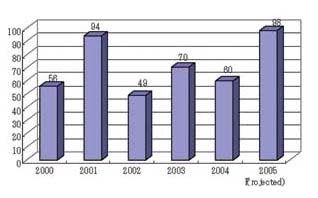Anne L. Fischer
The demand for CO2, YAG, THG YAG, and fiber and disk lasers is accelerating in Japan, according to the report “Laser Market in Japan 2006,” which was released by the Yano Research Institute Ltd. of Tokyo. Compiled by Sachiya Inagaki of the Electronics and Optics, Industry Technology Research Department, the study indicates that economic recovery in Japan, coupled with a renewed commitment to the industry, is the major force affecting increased capital investment in production facilities for laser oscillators and machines. The demand for laser technology is broadening across the automotive, flat panel display, semiconductor and electronic parts-related businesses.

The number of diode-pumped YAG lasers shipped doubled from 2000 to 2001 and was nearly halved during the economic downturn in 2002. Yano Research projects that 2005 sales will be shown to exceed the 2001 total, and it forecasts continued growth in this market.
CO2 lasers are once again in demand in the areas of parts design and microfabrication, where they are replacing conventional technologies such as the punching press. After experiencing a significant drop in the number of shipped units between 2000 and 2002 (from 1630 to 760 units, respectively), the shipment of these lasers was projected to reach as many as 1080 units in 2005, according to the report. That number is expected to grow as CO2 lasers are increasingly employed in remote (scan) welding.
The shipment of YAG lasers also has experienced an upward trend since the economic slowdown in 2002, when sales dropped to 2204 units, down from the record 3867 units sold in 2000. The report indicates that approximately 2900 units would be sold in 2005. It contends that demand for the devices will continue to increase, especially for micromachining electronic parts for digital consumer products.

The market for the relatively new THG YAG laser is expanding, and approximately 495 units were expected to have been sold in 2005, (up from 285 units in fiscal year 2000). Designed for ultramicromachining, the device meets the requirements for downsizing digital home appliances. It is expected that demand for the laser will continue to grow in applications such as scribing or dicing Si wafers and LCD substrates in the semiconductor and LCD industries.
Fiber laser production has experienced continued upward movement since its introduction to the market. According to the report, the steady demand reflects the fiber laser’s advantages over YAG and CO2 lasers for marking applications, most notably its higher beam quality, longer life and improved energy efficiency. The devices are driving the development of new applications and attracting new users, and the market for them was expected to grow from 170 units in fiscal 2000 to approximately 830 units in 2005.
Disk lasers offer many of the advantages of the fiber laser, and the report anticipates that they will be employed in the next generation of high-speed cutting and welding micromachining applications. Although wide-scale use is still limited because it is more expensive than other lasers, the disk laser is expected to replace conventional CO2 and YAG machines to some extent.
The 119-page report is available for $1950 from the Yano Research Institute (www.yanoresearch.com).